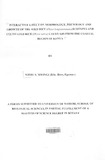| dc.contributor.author | Mwingi, Njeru S. | |
| dc.date.accessioned | 2013-03-18T12:00:54Z | |
| dc.date.issued | 2011 | |
| dc.identifier.uri | http://erepository.uonbi.ac.ke:8080/xmlui/handle/123456789/14477 | |
| dc.description.abstract | Rice is the third most important cereal crop in Kenya after maize and wheat. Among the major
constraints of rice production in Kenya is wild rice which occur in or near the rice fields as weeds or
in wild form. One of the important weeds is Oryza longistaminata which belongs to the sativa
complex with AA genome the same as cultivated rice (Oryza sativa L). 0. longistaminata is an
economically important weed in Kenya and there is need for the conservation of the species in its
natural form. This experiment was therefore, aimed at finding out the effect of interaction between
wild rice (0. longistaminata) and cultivated rice (0. sativa), by studying their morphology, phenology
and above ground biomass. Four ecotypes of 0. longistaminata were collected from the coastal region
ofKenya at Kipini, Fioni, Ramisi and Tana Delta. Two cultivars of 0. Sativa (Pishori and Basmati)
were got from the same region. Pishori is a landrace while Basmati is an improved variety. The
ecotypes and the cultivars were planted in pure and mixed stands in a screen house. Morphological
data which included plant height, number of tillers, flag leaf area and reproductive stages in growth of
a rice plant showed significant (P<O.05) differences in the wild/weedy populations from the cultivars
while the two cultivars did not show any significant (P>O.05) difference in their morphological
characteristics and phenology. The effect due to interaction between the weedy/wild ecotypes and the
cultivars was slightly shown in the Kipini weedy population. The above ground biomass was affected
by the cropping system, where, rice plants planted in pure stands had a higher biomass than the ones
planted in mixed stands. The wild/weedy populations had a lower biomass than the cultivars. These
results suggest that more time is needed for such a study and genetic markers used to detect the
possible development of new traits. Interaction of the wild/weedy populations of 0. longistaminata
and 0. Sativa cultivars may lead to alterations in morphology and phenology of the two. | en |
| dc.description.sponsorship | University of Nairobi | en |
| dc.language.iso | en | en |
| dc.publisher | University of Nairobi | en |
| dc.subject | Interactive effect | en |
| dc.subject | Morphology | en |
| dc.subject | Phenology | en |
| dc.subject | Wild rice (oryza longistaminata) ecotypes | en |
| dc.subject | Cultivated rice (oryza sativa) cultivars | en |
| dc.subject | Coastal region of Kenya | en |
| dc.title | Interactive effect on morphology, phenology and growth of the wild rice (oryza longistaminata) ecotypes and cultivated rice (oryza sativa) cultivars from the Coastal region of Kenya | en |
| dc.type | Thesis | en |
| local.publisher | School of Biological Sciences | en |

